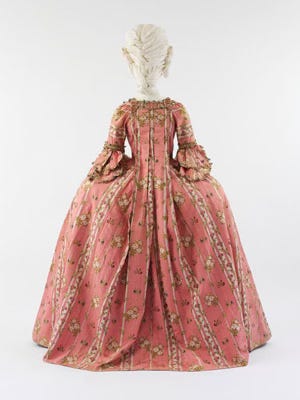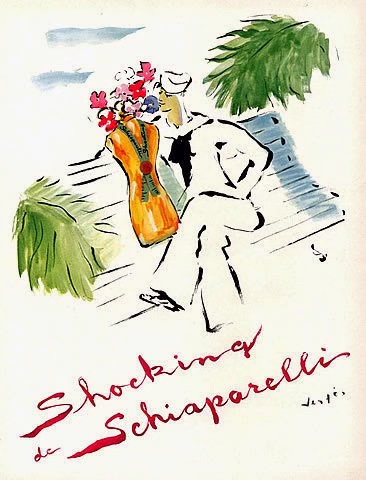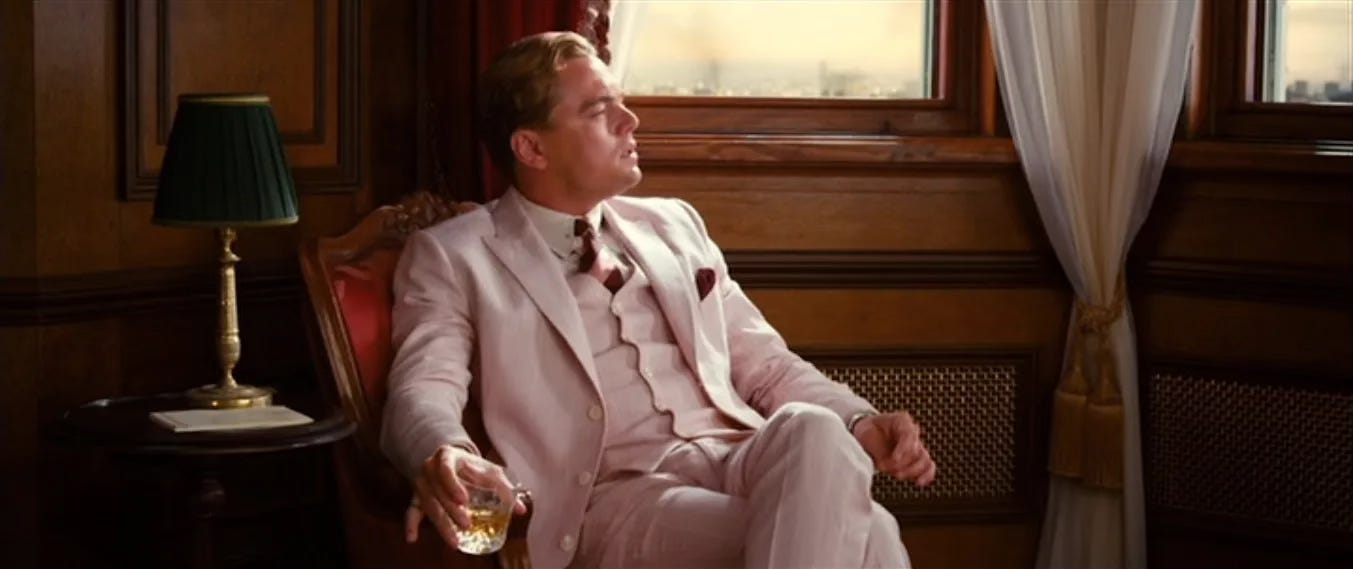Friday Frivolity no. 28: Think Pink!
Rose, coral, salmon, fuchsia, the blush of flushed flesh
This is an installment in the section Friday Frivolity. Every Friday, you'll get a little micro-essay, plus a mood board, 3 things I'm currently in love with, words of wisdom from what I've been reading lately, a shimmer of poetry, a "beauty tip," and a question to spark your thought.
—
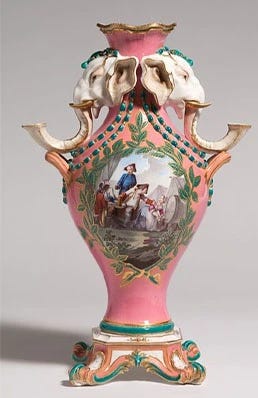
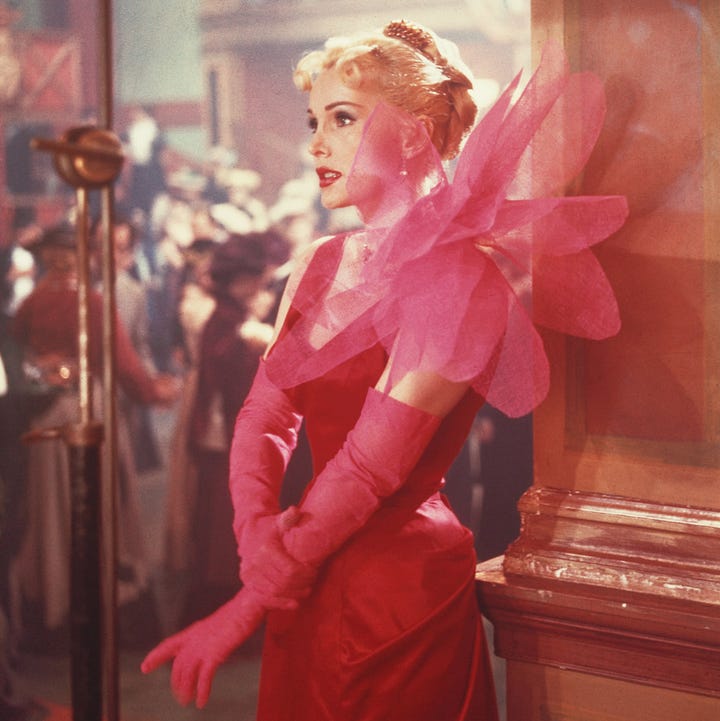
Think Pink!
The background image of my email inbox, an image of sea, sky, and horizon, shifts and changes with the time of day. Right now, sundown, it’s colored an intense pink that goes purplish at the edges, orangish towards the horizon. It’s unnatural and beautiful, startling in its distance from the calm, blue serenity of midday.
I've always loved this sunset-pink; a couple of days ago, taking a walk through the woods after a fresh snowfall, everything white and still and silent, I looked up through the dark web of branches and saw the clouds in the distance, tinged “rosy-fingered.” It is a peculiar salmon color the dusk takes on in the winter; there is a coldness to its heated hue, a kind of reticence within it that all things take on in these months of January and February. Yet pink rising against so much colorlessness is still cheering, still vitalizing, more a source of excitement than it would be in the summer, where it would lose itself among verdant grass and multicolored flowers and strong, blue-flowing rivers.
When pink occurs in nature, it comes mostly in the form of flowers: the pale pink of roses and peonies, the subdued serenity of April tulips, the brighter pom-poms of hydrangeas, the almost monstrous audacity of pink lilies and pink orchids. Pink creatures look foreign to us: think of a flock of flamingoes, perching on those skinny poles Nature gave them for legs, preening themselves, visitors from another planet. Then there is the pink of palms, the pink of the mouth’s inside, of tongue and taste, of our secret, inner places.
During the Renaissance, painters dabbled in pink, but it wasn’t until 18th-century France that pink really took off. It was a unisex hue but it was a hue of the wealthy, an exclusive hue. It dyed silks and ornamented clocks. Madame de Pompadour, mistress of the king, loved it, and so the Sèvres porcelain company turned out exquisite pieces in what they dubbed “Pompadour pink.” Associated with skin, pink has been an erotic color; in its more saturated, voluptuous tones, pink became an exotic color. “Pink is the navy blue of India,” Diana Vreeland once remarked.
Masculine and feminine—at first, considered as a lighter shade of red, pink was properly manly. In the 1950s, blue became the boy color, pink the girl. Arbitrary as this may be, somehow pink does seem peculiarly feminine: it has both a lightness and a warmth, a sweetness, a frivolousness. Against all the cynicism of my logical mind, a profusion of pink thrills the little girl in my heart.
Red is too strong, too bold, too heady, too bloodlike. Carnal, vital, forceful, energetic. Pink is red subdued, sweetened, coaxed to a gentler temper. Pink is the freshness of spring, the softness of the back of a flower petal still wet with dew. Red is blood but pink is flesh, a healthful flush, a spreading blush. A slow spread of pink reveals what the heart feels, inadvertently, almost against one’s will. Pink betrays—but so adorably, so sweetly, so innocently, it can’t help but be forgiven.
Mood Board of the Week
(left to right, top to bottom)
Cuno Amiet, Self-Portrait in Rose (1907): Cuno Amiet is a Swiss painter who grew interested in the use of pure color in painting in the 1890s. Although about 50 of his most significant paintings were wiped out in a fire in 1931, his remaining archive of over 4,000 more than makes up for it. Of those 4,000, a fourth are self-portraits, and my favorite is this one, where Amiet, manly beard and all, thoroughly embraces this most feminine hue. He seems almost to be caught in a shower of cherry blossom petals, a storm of sweetness.
Pink Chanel suit of Jacqueline Bouvier Kennedy, worn in 1963: On November 22, 1963, the President and the First Lady arrived in Dallas, Texas, the First Lady wearing a “watermelon pink” or “raspberry pink” suit of lightweight bouclé, trimmed with navy and set off by gold buttons. Before the trip, JFK had asked Jackie what she’d planned to wear. He gave her some advice: “There are going to be all these rich, Republican women at that lunch… wearing mink coats and diamond bracelets. And you’ve got to look as marvelous as any of them. Be simple—show these Texans what good taste really is.” And Jackie showed them, accessorizing the suit simply with white gloves and a matching pink pillbox hat. She continued to wear the suit, bloodstained and spattered with gore, in spite of people asking her if she wanted to change, even when VP Lyndon Johnson was sworn in as the next President, after her husband had been shot. “Somehow that was one of the most poignant sights,” said Lady Bird Johnson, “that immaculate woman, exquisitely dressed, and caked in blood.” Uncleaned, it remains in a windowless room in the National Archives where the air is changed six times an hour.
Pink silk gown, ca. 1775, from the Metropolitan Museum of Art: The robe à la française, also known by the decidedly less flattering name of the sack-back gown, began its life at the beginning of the 18th century as little more than a shapeless, dumpy garb. However, this seemingly humble dress had grand ambitions and in less than seven decades made a swift social climb to become the second-most formal style of ladies’ dress.
Pink dress by William Travilla, worn by Marilyn Monroe in Gentlemen Prefer Blondes (1953): Clothes maketh the (wo)man, and this hot pink number was the stellification of one of Hollywood’s most entrancing icons, killing off (at least onscreen) dear old Norma Jean and erecting in her place the scintillating sex symbol Marilyn Monroe. In this movie, Monroe’s comedic genius shines at its brightest, set off by the equal comedic genius of Jane Russell. Travilla, who would go on to design Monroe’s costumes for several more of her films, had first created a showgirl costume for the song, a glitzy mass of diamonds grafted onto a fishnet bodystocking. However, word got out that Monroe had posed nude for a calendar in 1949. Wanting to waft away this whiff of scandal, Travilla was instructed last-minute to design a new, more modest costume. The result was this shocking pink dress, strapless, made of peau d’ange (“angel skin”) silk, fitted with a matching pink belt, a large pink bow at the back, and long, pink gloves to set off diamond bracelets. As for the original showgirl dress, it went to Jane Russell, who, throwing off a mink coat, shook and shimmied and jangled its jewels before a scandalized courtroom in a scene that never fails to make me chortle.
Emile Vloors, A Choral Dance (1912): Emile Vloors (1871-1952) was a Belgian painter and sculptor whose works evince a quiet romanticism. I love the dreamy shades of pink in this painting, where the pink of seemingly endless blossoms merges with the pink of airy fabric. I’m reminded of the Homeric epithet for the dawn, rhododactylos, “rosy-fingered.”
Mean Girls (2004): Who can resist quoting, who can resist rejoicing at, who can resist acquiescing to that immortal adage, first voiced by Amanda Seyfried in the role of Karen Smith, “On Wednesdays we wear pink”? How much wisdom is contained in those five words! Only wear pink on Wednesdays, no matter that you have to borrow a men’s shirt about five sizes too big for you, and the Plastics just might let you sit with them.
Jeongmee Yoon, “Seowoo” from The Pink and Blue Project (2005): Photographer Jeongmee Yoon embarked upon The Pink and Blue Project for her master’s thesis. She was inspired by her five-year-old daughter, Seowoo, who fixated on the color pink, only wanting to wear pink clothes and play with pink toys. Seowoo is pictured here with her precious pink possessions organized methodically around her, laid out in a seemingly endless array of slippers, books, dolls, plastic knickknacks, necklaces, pencils, and Hello Kitties. Seowoo herself is hardly larger than the Hello Kitties; wearing pink pants, a shirt with pink sleeves, and a bright pink headband, she sits squished, in the corner, propped up on a pink pillow: the collector collected.
Noticing that many girls of Seowoo’s age, both in the U.S. and South Korea, shared a similar obsession with pink, and that this paralleled many boys’ obsession with blue, Yoon began to ask parents if she could photograph the collections of their children. The resulting compositions raise questions about gender, culture, childhood, consumerism, and what our collections mean to us.
Lisbon, Portugal, photographed by Gueorgui Pinkhassov in 1998: I love this pink building, and I think more buildings should be pink. Is it a coincidence that the photographer’s name is Pinkhassov? I dream of pink houses; I long for skyscrapers fuchsia, salmon, rose.
The Umbrellas of Cherbourg (1964): One of my favorite movies, Jacques Demy’s musical about two young lovers in the small maritime city of Cherbourg, is a perfect, riotous, unbelievably gorgeous study in color. Color film was made just to dance across Demy’s screen, to sing as the music of Michel Legrand soars and swells. In this shot, Catherine Deneuve wears a pink sweater and a pink bow in her hair, a shade subtler than the pink wallpaper behind her, emphasizing her youth and girlishness, while her mother, reflected in the mirror next to her, wears a deeper, more womanly red.
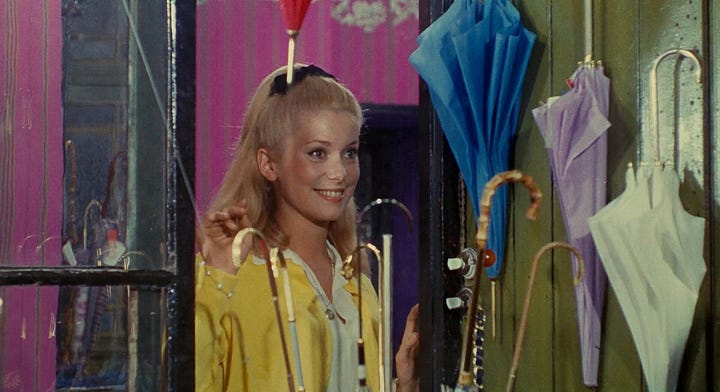

The Umbrellas of Cherbourg (1964)
Three Things I’m in Love With This Week
Stuart Semple, work #16897, The World’s Pinkest Pink (2016): In 2014, British-Indian artist Anish Kapoor, perhaps best known for Chicago’s Cloud Gate (better known as “The Bean”) infamously bought the exclusive rights to the pigment Vantablack, the world’s blackest black, so black that it can absorb up to 99.965% of the visible light around it, in 2014. This earned him the ire of many, including fellow British artist Stuart Semple. In 2016, Semple decided to create “the world’s pinkest pink,” a pink so pink it should be sold with protective glasses. Semple made this pink available to everyone except Anish Kapoor—exactly the kind of petty rivalry that makes the contemporary art world, if not spiritually enlightening, intellectually enriching, or technically enterprising, at least fun to watch from the sidelines. When you go to purchase Semple’s pink, you are required to affirm that “you are not Anish Kapoor, you are in no way affiliated to Anish Kapoor, you are not purchasing this item on behalf of Anish Kapoor or an associate of Anish Kapoor. To the best of your knowledge, information and belief, this paint will not make its way into the hands of Anish Kapoor.” But it turns out that pink is not the new black, and that Semple is still hankering after the ever-elusive Vantablack. In June 2024, Stuart Semple legally changed his name to Anish Kapoor. Will he finally get the world’s blackest black? Shall “Anish Kapoor” at last acquire Vantablack, thus barring himself, perhaps forever, from Semple pink? I eagerly await the answer.
Shocking perfume by Schiaparelli: Surrealist fashion designer Elsa Schiaparelli was inspired by her mentor, Paul Poiret, to begin incorporating scent offerings into her brand, enhancing the allure of her couture creations and fashioning a woman who would be thoroughly, shockingly Schiaparelli. Released in 1937, Shocking was a homage to the intensely vivid, eye-popping hue of rose Schiaparelli dubbed “Shocking Pink.” Writing in her autobiography, she remembers how she came up with the perfume’s name: “The colour flashed in front of my eyes. Bright, impossible, imprudent, becoming, life-giving, like all the light and the birds and the fish in the world put together, a colour of China and Peru but not of the West—a shocking colour, pure and undiluted.” The scent itself, created by Jean Carles, described by Vogue as “insinuating, warm, bold, persevering,” was a heady blend of jasmine, leather, and civet. It filled a flacon shaped like a dressmaker’s dummy, modeled after Mae West’s measurements, and garnished with multicolored flowers, a measuring tape around its neck signed “Schiaparelli.”
The mystery of pink diamonds: It was “Diamonds Are a Girl’s Best Friend” that Marilyn Monroe sang while wearing the hot-pink number described above, and if it didn’t ruin the ring of the thing, it would be an even truer assertion to state that “Pink Diamonds Are a Girl’s Bestest Friend.” Pink diamonds were first discovered in India, but over 90% of them actually come from the Argyle Mine in Australia, of which they constitute only 1% of the mine’s output (most are the rather less striking brown diamond). Scholars and scientists continue to debate why exactly the pink diamond is pink. Everyone agrees that the peculiar rosy tinge is due to a deformation in the stone’s crystal structure. But was this caused by seismic shock? Pressure? Radiation exposure? Those questions don’t need to be answered, however, by the purchasers of such diamonds—in 2017, the Pink Star diamond set the auction record for diamonds when it was sold for $71 million.
Words of Wisdom
“I hadn’t gone twenty yards when I heard my name and Gatsby stepped from between two bushes into the path. I must have felt pretty weird by that time, because I could think of nothing except the luminosity of his pink suit under the moon.”
—F. Scott Fitzgerald, The Great Gatsby
The Great Gatsby is a perfect book in my mind: short but complete, poetic but concise, lyrical but tightly plotted, its characters larger than life but all too human. That phrase, “the luminosity of his pink suit under the moon,” is so funny to me—I can just imagine Nick standing there, unable to get the image of Gatsby’s luminous, moonlight-dappled pink suit out of his mind after the shock of Myrtle Wilson’s death: in such moments, it’s often the little absurd details one tends, stupidly, to notice. Earlier on in the evening, Tom, Daisy’s husband and Gatsby’s rival for her love, exclaims about Gatsby, “An Oxford man! …Like hell he is! He wears a pink suit.” The pink suit marks out Gatsby as not one of “them,” not part of the blue-blooded circles in which Tom and Daisy move, inaccessible and remote and, no matter how much wealth Gatsby acquires, hopelessly out of reach. Later, when Nick remembers his goodbye to Gatsby and the last words he said to him, he remarks on how Gatsby’s “gorgeous pink rag of a suit made a bright spot of color against the white steps….” The pink suit differentiates Gatsby from Tom and Daisy but, in Nick’s mind, positively, an outward representation of the idealism, the romantic notions, the dreamer’s heart that undergird Gatsby’s chase of cold, corrupt cash.
Poetry Corner
Against Pink
Pink is an unhappy hue, not soothing like cerulean, nor calming like lavender or gray. It is the color of fingernails shorn away, blood dripping from the waxen quick. It is the color of a sunburned arm. The color of harm that lingers on cut shins for days. Pink is not the shade of buttercups or daisies. It is the color of poisonous brugmansia blooms, of poppies that bring on sleep. Pink saturates the face in anger. It is the cast left on a cutting board by a hunk of uncooked meat. Pink, too, is the bittersweet shade of passion subdued, passion that has slipped from burgundy to rose. It is only a tincture of desire and so carries the least conviction. It is the tint that drifts away unnoticed in the night. Be frightened of pink. Do not think it the innocent color of dresses or barrettes, the blush of areolas, strawberry snow cones, or grenadine martinis. Try, for once, to see it rightly. It is frightening. It is the hue of a person’s insides, the color of a womb. That room where life arises. That room where babies are made. Where arms, legs, and heads are created. Eyes, blood, and tiny teeth.
I don’t agree with Elerath—for me, pink is always a happy hue, and its sight never fails to bring a touch of brightness to my day, which is what makes this poem so arresting right from its beginning. Elerath uncouples pink’s associations with innocence, girlishness, peppy femininity. For her, pink is the color of pain, of passion gone cold, of flesh and all “the thousand natural shocks that flesh is heir to.” Pink is a color that somehow seems more artificial than its fellow tints and tinctures, but it’s actually the most natural of colors, the color of our own, squirming insides, of our mortality and our bestial baseness. Elerath’s inclusion of “tiny teeth” is interesting because babies don’t, in fact, exit “that room where life arises” armed with miniature fangs. However, we all come out of the womb with the potential to harm and be harmed—it is our inevitable inheritance, a condition of our being in the world, and why shouldn’t that be symbolized, after all, by fleshy, writhing, wet, smooth, tender pink?
Beauty Tip
Embrace the power of pink and add a pop of this hue to a typically dull outfit or area of your home. Or buy a gorgeous, beautiful bouquet of pink flowers!
Lingering Question
If you were a color, what color would you be?
Dear Readers, Happy Valentine’s Day!! I hope you enjoyed this Valentine’s edition—last week’s was also Valentine’s-related, I guess, but I just couldn’t resist! As always, if you enjoyed, like this post, share with a friend, and it always makes me happy to hear your opinions in the comments!





